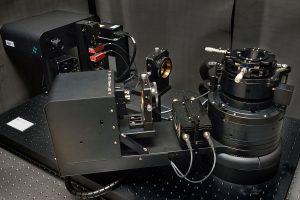Supervisor/Coordinator: Chinedum Osuji
Phone: 215-573-3608
Email: cosuji@seas.upenn.edu
 The LRSM installed a new Multi-angle Light Scattering Instrument – an LS Spectrometer, from LS instruments in the Spring of 2023. This instrument enables a broad range of materials characterization through static and dynamic light scattering. Capabilities enabled by the SLS/DLS instrument include particle size determination, studies of relaxation dynamics, and investigation of thermodynamic interactions of species in suspension (e.g., nanoparticles; polymers; colloidal species).
The LRSM installed a new Multi-angle Light Scattering Instrument – an LS Spectrometer, from LS instruments in the Spring of 2023. This instrument enables a broad range of materials characterization through static and dynamic light scattering. Capabilities enabled by the SLS/DLS instrument include particle size determination, studies of relaxation dynamics, and investigation of thermodynamic interactions of species in suspension (e.g., nanoparticles; polymers; colloidal species).
The instrument is equipped with a 3D Cross-correlation capability that enables it to distinguish intensity decorrelation that originates from single vs multiple scattering events. As a result, the instrument can be used to collect dynamic light scattering data from samples that exhibit multiple scattering, i.e. concentrated, opaque systems. The Modulated 3D Cross-Correlation option enhances the signal from the cross-correlation measurement. Additional options include sample rotation (for measurements of non-ergodic systems), and temperature resolved measurements.
Standard measurements:
- Particle sizing: hydrodynamic Radius (Rh) and radius of gyration (Rg)
- Size distribution and polydispersity
- Particle dynamics: diffusion coefficient, mean square displacement,
- Polymer molecular weight (MW ~ 360 – 3600000 Dalton)
- 2nd virial coefficient
- Rayleigh ratio
- Form and structure factors
- Inter-particle distance in charged systems
- Aggregation
- Etc.
Specifications:
| Sample volume | 50 μL to 4 ml |
| Particle size range (Rh) | 0.15 nm to 5 μm |
| Radius of gyration (Rg) | 5 nm to 5 μm |
| Molecular weight | 360 – 3,600,000 Dalton |
| Angular range | 12° to 150° (+/- 0.01°) Recommended 15° to 150° |
| Laser | Fiber-coupled laser 120 mW, 638 nm |
| Correlator | 320 channels, delay time 12.5 ns to 15 h, auto- and cross-correlation |
| Temperature | up to 90 °C |
For light scattering tutorials:
- LS Spectrometer User Manual
- LS Instrument Training Presentation
- Manual Zim Plot
- Reports and Additionals (Access request needed for download)
- Python Code Demo for Plotting
Facilities users must include the following text in the acknowledgment section of their publications:
“The authors acknowledge the use of facilities supported by the Laboratory for Research on the Structure of Matter and the NSF through the University of Pennsylvania Materials Research Science and Engineering Center (MRSEC) DMR-2309043.”
